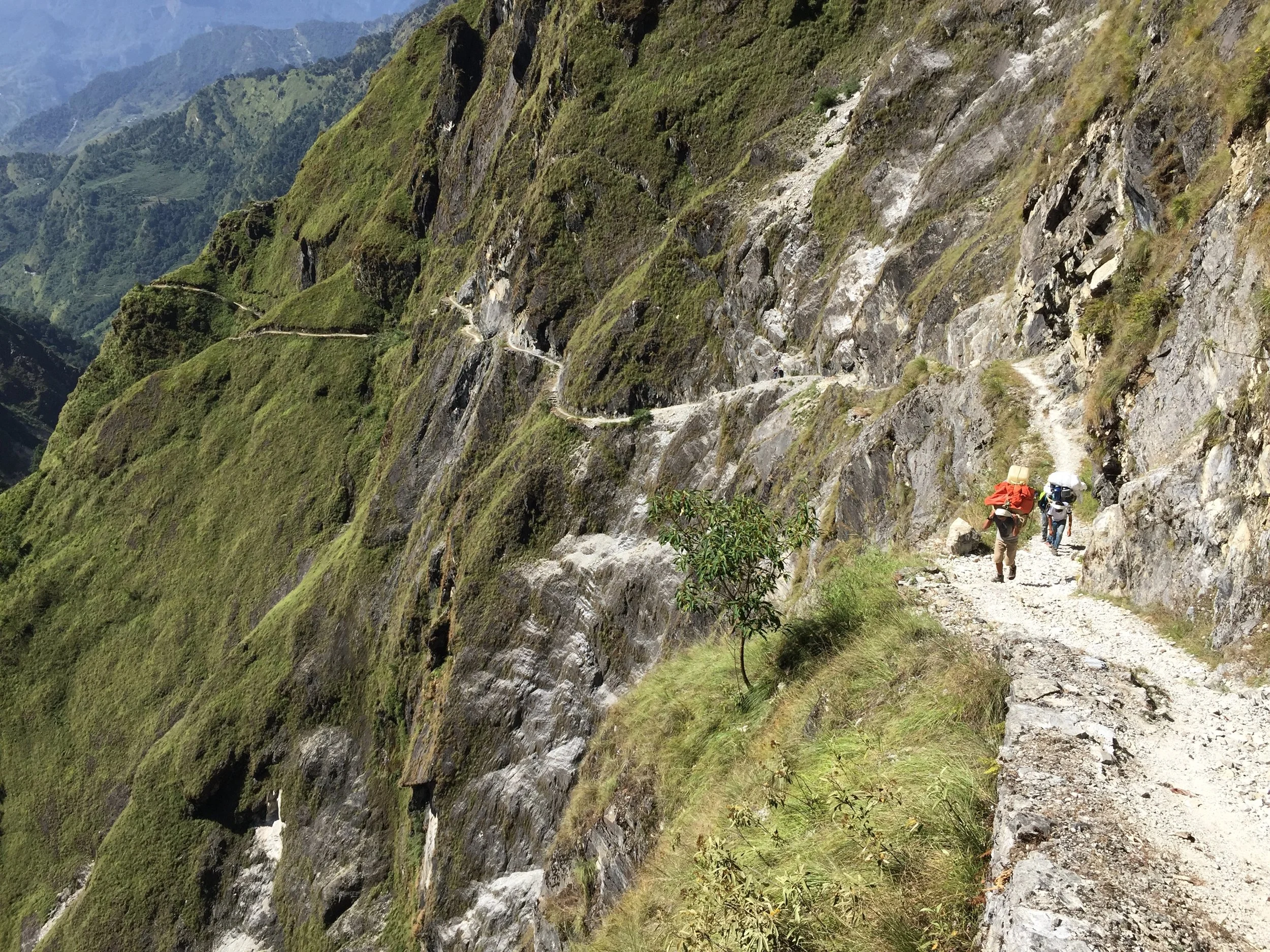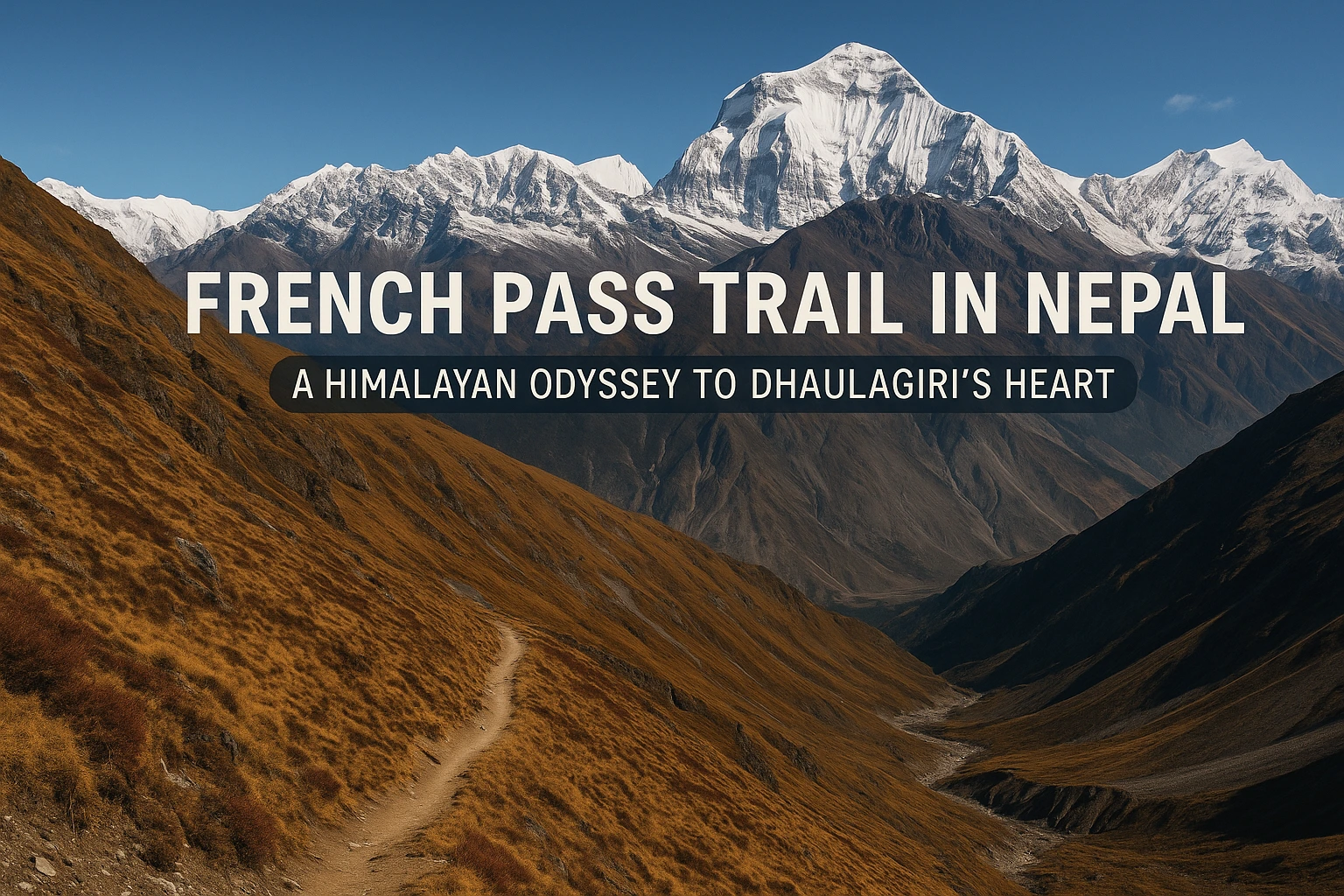Introduction to the French Pass Trail in Nepal
The French Pass Trail in Nepal, a highlight of the Dhaulagiri Circuit Trek, is a high-altitude adventure that beckons seasoned trekkers to the remote Dhaulagiri region. Nestled beneath the towering Dhaulagiri massif— the world’s seventh–highest peak at 8,167 meters— French Pass (5,360 meters) offers breathtaking vistas of snow-clad peaks, glaciers, and the surreal Hidden Valley.
Unlike the bustling Everest or Annapurna trails, this off-the-beaten-path trek promises solitude, raw wilderness, and an authentic Himalayan experience.
Named after French mountaineers who explored the region in the 1950s, the French Pass Trail in Nepal combines challenging terrain with cultural immersion in Magar and Gurung villages. This article provides a detailed guide, including a 21–day itinerary from Himalayan Dreams, practical tips, cultural insights, and answers to frequently asked questions, ensuring you’re well-prepared for this unforgettable journey.




Geography and Scenic Beauty
The French Pass Trail in Nepal is part of the Dhaulagiri Circuit, a 170-kilometer loop starting from Beni, a town at the confluence of the Myagdi River and Kali Gandaki gorge. The trail ascends through terraced fields, dense forests, and Magar villages before entering the alpine wilderness of glaciers and moraines. Key landmarks include:
- Dhaulagiri Base Camp (4,550 meters): A staging point with views of Dhaulagiri I’s icefall and Tukuche Peak.
- French Pass (5,360 meters): The trek’s highest point, offering 360-degree views of Dhaulagiri, Mukut Himal, and Sita Chuchura.
- Hidden Valley (4,860 meters): A high–altitude basin surrounded by peaks, evoking a sense of isolation.
- Thapa (Dhampus) Pass (5,250 meters): A secondary pass with vistas of the Annapurna range.
The trail’s diverse landscapes—from subtropical forests to icy glaciers—make it a visual feast, with highlights like the world’s deepest gorge, Kali Gandaki, and the charming village of Marpha, famous for its apple orchards.


Historical and Cultural Significance
The French Pass Trail in Nepal owes its name to French expeditions, notably led by Maurice Herzog, who attempted Dhaulagiri’s summit in the 1950s. These efforts marked the region as a mountaineering frontier, with French Pass becoming a gateway to the Hidden Valley, a remote Shangri–La–like basin.
Culturally, the trail weaves through villages inhabited by Magar, Gurung, and Chhetri communities. In places like Dharapani and Muri, trekkers encounter terraced fields, stone-paved paths, and Buddhist stupas adorned with prayer flags, reflecting Tibetan-influenced heritage.
The Magar village of Muri offers glimpses of traditional lifestyles, while Marpha’s apple brandy and monasteries provide a warm cultural finale. Engaging with locals, respecting customs, and supporting small shops enriches the trekking experience.

Challenges of the French Pass Trail
The French Pass Trail in Nepal is a strenuous trek requiring physical fitness, high-altitude experience, and mental resilience. Key challenges include:
- High Altitude: Crossing the French Pass at 5,360 meters risks acute mountain sickness (AMS). Acclimatization days at the Italian Base Camp and Dhaulagiri Base Camp are essential.
- Rugged Terrain: The trail features steep ascents, rocky moraines, and snow-covered slopes. Crossing French Pass may require crampons and ice axes, especially in snowy conditions.
- Weather Variability: High passes are prone to sudden snowstorms and strong winds, necessitating reserve days.
- Remoteness: Beyond Dobhan, there are no permanent settlements, requiring tented camps and self-sufficiency.
- Endurance: Daily treks of 6-9 hours, like the 8-9-hour climb to French Pass, demand stamina.
Despite these hurdles, the trail’s rewards—panoramic Himalayan views and a sense of accomplishment—are unmatched.
Ecological Highlights
The French Pass Trail in Nepal spans diverse ecosystems, from lowland oak and bamboo forests to high-altitude deserts. Lower trails feature rhododendron blooms (spring) and wildlife like musk deer, while higher altitudes reveal glacial landscapes and rare species like snow leopards in the Hidden Valley.
The trail skirts the Dhaulagiri Conservation Area, emphasizing the need for Leave No Trace principles to protect this fragile environment.
Itinerary: 21-Day Dhaulagiri Loop and French Pass Trekking
Below is the detailed 21-day itinerary sourced from Himalayan Dreams, designed for acclimatization and scenic exploration:
- Day 1: Arrive in Kathmandu (1,400m)
Transfer to a 4–star hotel, enjoy a welcome dinner with a Nepalese cultural program. - Day 2: Kathmandu Sightseeing
Visit UNESCO sites like Pashupatinath, Boudhanath, and Kathmandu Durbar Square. Prepare for the trek. - Day 3: Fly to Pokhara (850m)
Scenic 25-minute flight, overnight in Pokhara. - Day 4: Drive to Darbang (1,180m), Trek to Dharapani (1,200m, 7 hours)
Drive 3-4 hours, trek through Magar villages with Dhaulagiri views. - Day 5: Trek to Muri (1,850m, 6-7 hours)
Ascend through terraced fields, enjoy Gurja Himal vistas. - Day 6: Trek to Boghara (2,080m, 6 hours)
Pass bamboo stands and farmhouses, and camp near fields. - Day 7: Trek to Dobhan (2,520m, 6 hours)
Navigate steeper trails, cross rivers, and enter forested areas. - Day 8: Trek to Sallaghari (2,820m, 6 hours)
Climb through moraine terrain, glimpse Dhaulagiri’s west wall. - Day 9: Trek to Italian Base Camp (3,660m, 4 hours)
Short trek through rhododendron forests, acclimatize. - Day 10: Rest and Acclimatization
Explore Italian Base Camp, prepare for higher altitudes. - Day 11: Trek to Glacier Camp (4,200m, 6 hours)
Cross moraines and glaciers, camp near Chhongardan Glacier. - Day 12: Rest and Acclimatization
Adjust to altitude, enjoy glacier views. - Day 13: Trek to Dhaulagiri Base Camp (4,550m, 4 hours)
Reach the base camp with stunning icefall views. - Day 14: Rest and Acclimatization
Acclimatize, explore Dhaulagiri’s surroundings. - Day 15: Trek to Hidden Valley via French Pass (4,860m via 5,360m, 8-9 hours)
Cross French Pass, descend to Hidden Valley’s high–altitude campsite. - Day 16: Rest in Hidden Valley
Explore the valley or relax, optional ridge walks for views. - Day 17: Trek to Alubari via Thapa Pass (3,900m via 5,250m, 9 hours)
Cross Thapa Pass, descend to the Annapurna region for views. - Day 18: Trek to Jomsom via Marpha (2,670m, 5 hours)
Descend to Marpha’s apple orchards, continue to Jomsom. - Day 19: Fly to Pokhara
20-minute flight from Jomsom, relax in Pokhara. - Day 20: Fly to Kathmandu
Return to Kathmandu, enjoy a free evening. - Day 21: Final Departure
Transfer to Tribhuvan International Airport.
This itinerary includes acclimatization days, private transfers, domestic flights, and a guided experience with Sherpas and porters.

Practical Tips for Trekking
- Best Time: Spring (March-May) and autumn (September-November) offer stable weather and clear views.
- Permits: Obtain Annapurna Conservation Area Permit (ACAP, $30) and TIMS card ($20) in Kathmandu or Pokhara.
- Guides and Porters: A licensed guide is recommended for navigation and safety, with porters carrying up to 15kg per person.
- Gear: Pack layered clothing, a four-season sleeping bag, trekking poles, crampons, an ice axe, and water purification tablets. Rent high-quality gear in Kathmandu if needed.
- Physical Preparation: Train for 6-8 weeks with cardio, strength exercises, and hiking with a loaded backpack.
- Safety: Carry travel insurance for high-altitude trekking and evacuation, plus a first-aid kit with Diamox for AMS.
- Cost: Expect $2,500-$4,500 for a guided trek, including permits, crew, and flights.
Cultural Etiquette
Greet locals with “Namaste,” dress modestly, and ask permission before photographing. Walk to the left of stupas and prayer flags, and tip guides/porters 10-15% of the trek cost.

Why Choose the French Pass Trail?
The French Pass Trail in Nepal offers unparalleled solitude, stunning Himalayan vistas, and cultural immersion. Crossing French Pass and Thapa Pass, trekkers experience the thrill of high-altitude adventure and the serenity of Hidden Valley. For those with trekking experience, this trail is a chance to conquer a Himalayan classic.
Frequently Asked Questions (FAQs)
1. How difficult is the French Pass Trail in Nepal?
The trail is very strenuous, requiring high-altitude experience, physical fitness, and technical skills for snow-covered passes. It’s rated 5/5 for difficulty due to 6-9-hour trekking days and altitudes above 5,000 meters.
2. Do I need a guide for the French Pass Trail?
While not mandatory, a licensed guide is highly recommended for navigation, safety, and cultural insights, especially in remote areas with no settlements.
3. What is the best time to trek the French Pass Trail?
Spring (March-May) and autumn (September-November) offer stable weather and clear views. Winter is possible but colder, and the monsoon season (June-August) brings rain and landslides.
4. How long does the French Pass Trail take?
The Dhaulagiri Circuit, including French Pass, takes 18-21 days, with the Himalayan Dreams itinerary spanning 21 days for ample acclimatization.
5. What permits are required?
You need an Annapurna Conservation Area Permit (ACAP, $30) and a TIMS card ($20), obtainable in Kathmandu or Pokhara.
6. Can beginners trek the French Pass Trail?
No, this trek is not suitable for beginners due to its high altitude, rugged terrain, and remoteness. Prior high-altitude trekking experience is essential.
7. What wildlife might I see on the trail?
You may spot musk deer, blue sheep, or, rarely, snow leopards in Hidden Valley. Lower trails feature pheasants and other birdlife.
8. Is the French Pass Trail crowded?
No, it’s one of Nepal’s least crowded treks, offering solitude compared to Everest or Annapurna routes.
Reference: https://www.himalaya-info.org/Map%20dhaulagiri_himal.htm

